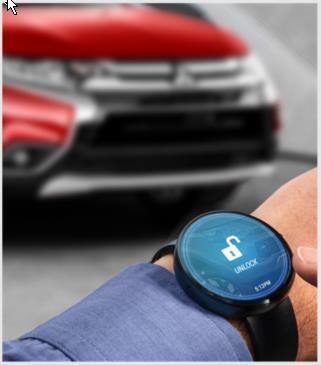Biometrics: The Key to Your Car

Advanced technology, which makes cars harder to steal, also makes car keys harder to copy. So while losing a car key has never been fun, these days it’s an expensive proposition that most consumers would rather avoid. One solution is to let wearables act as car keys. With at least a quarter of American adults owning a wearable and estimates on wearable adoption continuing to rise, this may be the ideal way for cars to recognize and authenticate their owners. At Mitsubishi Electric, we’ve been investigating a biometric wearable strategy for vehicle authentication and have come up with the following ideas we’d like to share.
Lifestyle branding
Car-aware wearables could provide automakers with the perfect way to extend a premium brand onto an owner’s wrist. A Cadillac, Lexus, Mercedes, or Porsche wrist strap would allow consumers to enter their cars while acting as an extension of those same brand qualities into other mobility spaces. Rather than a single-purpose widget, an OEM-branded biometric wearable could interface with a smart home, favorite apps, personal devices, or enterprise equipment, giving OEMs a much broader mobility presence. This capability could also take advantage of consumers’ existing wearables with branded applications on FitBit, Apple Watch, or Android Wear.
Car-sharing convenience
Biometric wearable unlocking carBiometric wearables could make a great accessory for car sharing. By authenticating the owner through their biometric identification, a car sharing service could guarantee proper access to whatever vehicles an individual is allowed to use without needing to worry about pass codes or physical keys. That freedom could extend to car subscription models where someone swaps cars on a dealer lot at will, with a person’s biometric data providing the link to an online account, payment, and insurance details.
In addition to replacing the physical key, car rentals, car sharing, and ride sharing would all benefit from the car’s ability to confidently and uniquely recognize an individual through personalization. Biometric identification would allow a car to automatically access and provide many convenience features like smartphone pairing, calendar syncing, and routing to preset locations from either personal mobile or cloud repositories. People’s preferred traveling identities would follow them wherever they go without worry about smartphone loss or theft.
Remote control
With a biometric wearable and a smart watch, people would have the ability to remotely control their car from anywhere with more identity assurance than a physical key fob. Your customer could roll down the windows and unlock the car for the kids while still inside packing lunches. Or they could open the trunk to let the neighbor borrow a scissor jack while they’re on vacation.
Increased security
Accessing cars via biometric prints means that consumers can’t lose their “keys”. It also means that someone can’t steal someone else’s key and thus their car without the appropriate and unique fingerprint, iris, voice, or ECG. Biometric security also makes it far simpler for fleet or business owners to provision vehicles since transferring cars could take place via a few mouse clicks instead of a cumbersome exchange of key fobs.
Improved UX
Biometrics could identify everyone in the vehicle, not just the owner (or whomever’s got the key fob). This fine-grained information about a car’s occupants could provide a much improved experience, from individual mobile payments to per-seat personalization. With individual identification, the infotainment system could automatically adapt to the driver and front-seat passenger, and rear-seat entertainment could show everyone’s favorite shows.
These are just some of the reasons we think biometrics will gain traction within automotive. We’ll be showcasing a subset of these use cases on our booth at CES 2018 – be sure to make an appointment to see them and our other innovations.


